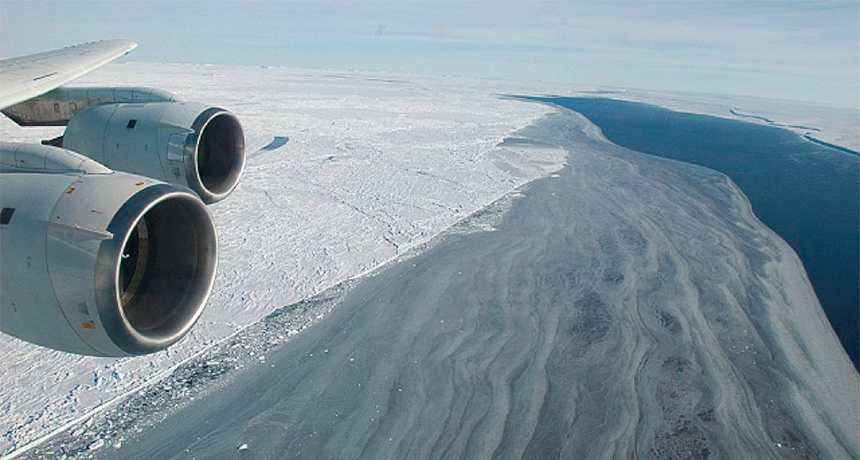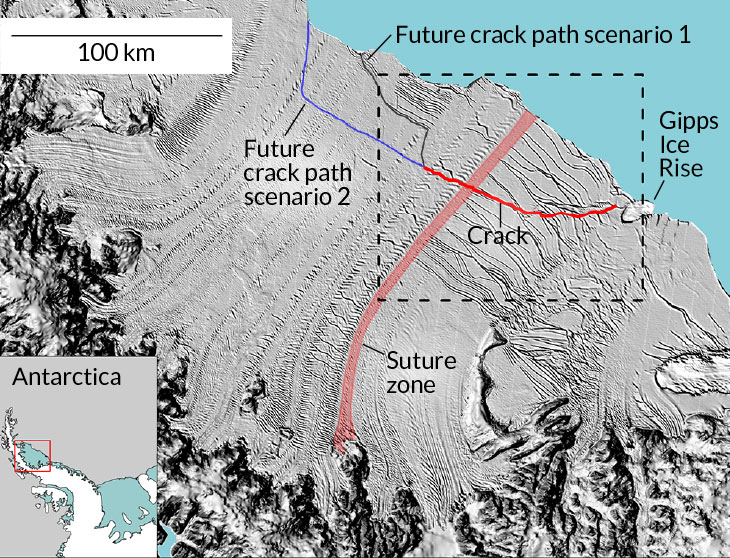
BREAK UP Last year a crack stretching tens of kilometers rapidly spread across Larsen C, shown here in 2009, one of the largest ice shelves in Antarctica. The crack could break off a massive area of ice and threaten the ice shelf’s stability.
Michael Studinger/NASA Goddard Space Flight Center
- More than 2 years ago
Scientists have spotted the mortal wound that could prompt the collapse of Antarctica’s fourth-largest ice shelf.
Satellite images reveal that a crack in Larsen C rapidly extended tens of kilometers across the ice shelf in 2014. If the crack reaches the ice shelf’s edge, it could snap off a Delaware-sized area of ice, researchers report June 15 in The Cryosphere. Such a loss would reduce Larsen C’s size by about 10 percent, enough to shrink the shelf to its smallest size in recorded history and potentially start the shelf’s disintegration.
Lead author Daniela Jansen, a glaciologist at the Alfred Wegener Institute for Polar and Marine Research in Bremerhaven, Germany, expects that the crack will chip apart Larsen C within five years. “We should keep a close eye on Larsen C,” she says. “It might not be there for so much longer.”
Since Larsen C’s ice already floats in the ocean, the big break-off won’t immediately raise global sea levels. But if the shelf collapses — as happened to Larsen C’s siblings, Larsen A and Larsen B (SN: 10/18/14, p. 9) — then glacial ice could flow into the sea unabated.
Larsen C, covering about 55,000 square kilometers, is the largest ice shelf along the Antarctic Peninsula. The shelf is fed by several mountain glaciers that flow from the continent’s interior into the ocean like fingers connected to a palm. Relatively warm marine ice fills the gaps between the glaciers and sews the ice shelf together. These long suture zones are more malleable than the surrounding glacial ice and are less likely to crack when squeezed or pulled.
Story continues below map

Near Larsen C’s edge is the Gipps Ice Rise, a rocky bump in the landscape that blocks the flow of ice into the ocean. Ice often fractures as it moves around the ice rise, creating long cracks that run perpendicular to the suture zones. The cracks extend all the way to the bottom of the ice and grow until they hit a stable suture zone. Dozens of cracks neatly terminate along the suture zone near the Gipps Ice Rise.
In November 2014, Jansen assembled images of Larsen C taken by NASA’s Landsat satellites and noticed something unusual: One of the cracks had spread past the suture zone and was more than halfway toward breaking off a large section of the ice shelf. Archived satellite images revealed that the crack grew between late 2010 and late 2012 before reaching the suture zone and stabilizing. During 2014, the crack abruptly broke through the suture zone and grew roughly 20 kilometers in less than nine months.
Jansen and colleagues simulated likely paths that the crack could take as it spreads toward the ice shelf’s edge. In one scenario, the crack cut off 6,400 square kilometers of ice from the shelf and shrunk Larsen C by 12 percent.
For now the researchers are literally in the dark about Larsen C’s status. Not enough light reaches Antarctica during winter for satellites to accurately monitor the ice shelf. When daylight returns in August, the team will get its first look at whether the crack has spread in the last few months.
The exact cause of the crack’s unexpected growth is unknown. But it could be related to higher ocean and air temperatures that have thinned the ice shelf, says Eugene Domack, an earth scientist at the University of South Florida in St. Petersburg. If the crack growth “is somehow related to a somewhat thinner ice shelf than what we’re traditionally used to,” he says, “then it opens up this idea of slow thinning as a gradual lead-up to a more catastrophic decay.”
A better understanding of how and why the Larsen C crack expanded so quickly could help scientists better predict the future of all Antarctic ice shelves, says Richard Alley, a glaciologist at Penn State. “We live in a world now where the future of the ice sheet depends in part on fracturing mechanics.”






